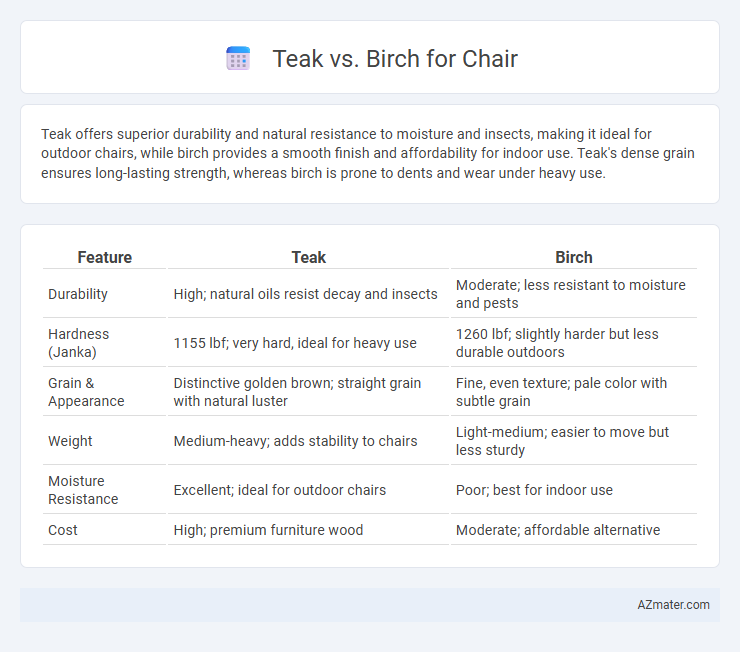Teak offers superior durability and natural resistance to moisture and insects, making it ideal for outdoor chairs, while birch provides a smooth finish and affordability for indoor use. Teak's dense grain ensures long-lasting strength, whereas birch is prone to dents and wear under heavy use.
Table of Comparison
| Feature | Teak | Birch |
|---|---|---|
| Durability | High; natural oils resist decay and insects | Moderate; less resistant to moisture and pests |
| Hardness (Janka) | 1155 lbf; very hard, ideal for heavy use | 1260 lbf; slightly harder but less durable outdoors |
| Grain & Appearance | Distinctive golden brown; straight grain with natural luster | Fine, even texture; pale color with subtle grain |
| Weight | Medium-heavy; adds stability to chairs | Light-medium; easier to move but less sturdy |
| Moisture Resistance | Excellent; ideal for outdoor chairs | Poor; best for indoor use |
| Cost | High; premium furniture wood | Moderate; affordable alternative |
Introduction to Teak and Birch Woods
Teak wood, prized for its natural oils and dense grain, offers exceptional durability and resistance to moisture, making it ideal for chair construction. Birch wood features a fine, even texture and pale color, known for its strength and smooth finish that enhances comfort and aesthetics. Both woods provide unique benefits, with teak excelling in outdoor resilience and birch favored for indoor furniture elegance.
Key Differences Between Teak and Birch
Teak offers exceptional durability and natural resistance to moisture, making it ideal for outdoor chairs, while birch is a hardwood with a lighter color and smooth grain, better suited for indoor furniture. Teak's high oil content and dense structure provide superior longevity and weather resistance compared to birch, which requires protective finishes to prevent damage. Birch is generally more affordable and easier to work with, but teak's premium strength and aesthetic appeal justify its higher cost in furniture design.
Appearance and Grain Patterns
Teak chairs showcase a rich golden-brown hue with a straight grain pattern that often features natural streaks, lending a luxurious and warm appearance. Birch chairs present a lighter, creamy color with a fine, even grain that offers a smooth and subtle aesthetic. The distinct grain of teak emphasizes durability and elegance, while birch provides a clean and minimalist look ideal for contemporary furniture.
Durability and Longevity
Teak wood offers superior durability and longevity for chairs due to its high natural oil content, which resists moisture, pests, and decay, making it ideal for both indoor and outdoor use. Birch, while strong and hard, is more susceptible to wear and humidity damage, requiring regular maintenance to maintain its appearance and structural integrity. Chairs made from teak typically last several decades with minimal upkeep, whereas birch chairs may deteriorate faster in environments with variable moisture levels.
Resistance to Moisture and Pests
Teak wood is renowned for its exceptional resistance to moisture and pests, making it ideal for chairs used in humid or outdoor environments due to its high natural oil content that repels water and insects. Birch, while durable and fine-grained, lacks the inherent moisture and pest resistance of teak, requiring protective finishes to prevent damage when exposed to damp conditions. Therefore, teak offers superior longevity and low maintenance in environments prone to moisture and pest exposure compared to birch.
Comfort and Ergonomics in Chair Design
Teak chairs offer exceptional comfort due to their natural wood grain, which provides slight flexibility and warmth, enhancing ergonomic support for prolonged seating. Birch, being a lighter and harder wood, delivers firm support with a smooth finish that suits chairs designed for short-term use or decorative purposes. Ergonomically, teak's durability coupled with its ability to contour subtly under weight makes it ideal for chairs aiming to combine comfort with structural integrity.
Maintenance and Care Requirements
Teak chairs require minimal maintenance due to their natural oil content, which resists water and pests, making them ideal for outdoor use with only occasional cleaning and oiling recommended to maintain their rich color. Birch chairs demand more upkeep, as they are prone to moisture damage and require regular sealing or varnishing to protect against wear and humidity, especially in high-traffic or outdoor environments. Proper care for teak extends its lifespan with less effort, while birch necessitates consistent attention to prevent cracking and warping.
Environmental Impact and Sustainability
Teak wood, known for its natural oils and durability, is climate-resilient and often harvested from responsibly managed plantations, contributing to reduced deforestation risks. Birch, a fast-growing hardwood, offers a renewable option with lower carbon footprint due to its faster growth cycle and widespread availability in temperate regions. Choosing FSC-certified teak or birch ensures sustainable sourcing, minimizing environmental impact while supporting biodiversity and carbon sequestration efforts.
Cost Comparison: Teak vs Birch Chairs
Teak chairs typically cost more than birch chairs due to teak's natural durability, resistance to weather, and rich grain that enhances aesthetic appeal. Birch chairs offer a budget-friendly alternative with moderate strength and a lighter, uniform appearance, making them ideal for indoor use without extensive environmental exposure. Choosing between teak and birch often depends on budget constraints and the chair's intended use, as teak's higher price reflects its superior longevity and maintenance benefits.
Choosing the Right Wood for Your Chair
Teak offers exceptional durability and resistance to moisture and pests, making it ideal for outdoor chairs that require long-lasting strength and natural beauty. Birch provides a lighter, more affordable option with a smooth grain that easily accepts paint and stain, perfect for indoor chairs seeking a modern, clean look. Choosing between teak and birch depends on the chair's environment and desired aesthetic, with teak excelling in weather resistance and birch favored for versatility and affordability.

Infographic: Teak vs Birch for Chair
 azmater.com
azmater.com